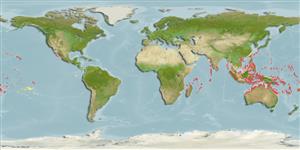Environment: milieu / climate zone / depth range / distribution range
Ecologia
marino associati a barriera corallina; distribuzione batimetrica 3 - 20 m (Ref. 90102). Tropical; 30°N - 24°S
Indo-Pacific: East Africa to the Marquesan Islands, north to the Ryukyu Islands, south to northern Australia, New Caledonia and Rapa. Throughout Micronesia (Ref. 1602).
Size / Peso / Age
Maturity: Lm ? range ? - ? cm
Max length : 24.0 cm TL maschio/sesso non determinato; (Ref. 4201)
Spine dorsali (totale) : 11; Raggi dorsali molli (totale) : 11 - 13; Spine anali: 4; Raggi anali molli: 7 - 9. Head and body silvery, scales often with blackish spot in centre (Ref. 4201). LL scales with pale red spot and black edges (Ref. 4201).
Found mainly around oceanic islands (Ref. 9710). It is an uncommon inhabitant of reef flats, lagoon and semi-sheltered seaward reefs to depths over 20 m. Occurs with N. sammara in coral-rich areas with large staghorn Acropora corals. Feeds mainly on benthic invertebrates (Ref. 11889).
Life cycle and mating behavior
Maturità | Riproduzione | Deposizione | Uova | Fecundity | Larve
Myers, R.F., 1991. Micronesian reef fishes. Second Ed. Coral Graphics, Barrigada, Guam. 298 p. (Ref. 1602)
IUCN Red List Status (Ref. 130435: Version 2024-1)
Threat to humans
Harmless
Human uses
Strumenti
Special reports
Download XML
Fonti Internet
Estimates based on models
Preferred temperature (Ref.
123201): 25.2 - 29.3, mean 28.4 °C (based on 2871 cells).
Phylogenetic diversity index (Ref.
82804): PD
50 = 0.5312 [Uniqueness, from 0.5 = low to 2.0 = high].
Bayesian length-weight: a=0.01950 (0.01214 - 0.03132), b=2.94 (2.80 - 3.08), in cm total length, based on LWR estimates for this species & (Sub)family-body (Ref.
93245).
Trophic level (Ref.
69278): 4.0 ±0.59 se; based on food items.
Resilienza (Ref.
120179): Alto, tempo minimo di raddoppiamento della popolazione meno di 15 mesi (Preliminary K or Fecundity.).
Fishing Vulnerability (Ref.
59153): Low vulnerability (14 of 100).
Nutrients (Ref.
124155): Calcium = 68.7 [31.1, 214.1] mg/100g; Iron = 0.693 [0.278, 1.457] mg/100g; Protein = 18.8 [17.6, 20.0] %; Omega3 = 0.159 [0.065, 0.380] g/100g; Selenium = 27.1 [15.3, 53.9] μg/100g; VitaminA = 82.9 [30.7, 235.8] μg/100g; Zinc = 1.27 [0.81, 1.98] mg/100g (wet weight);
